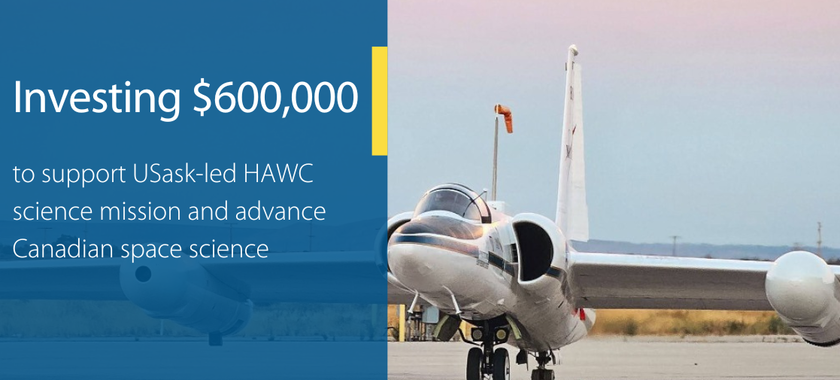Innovation Saskatchewan is investing $600,000 over three years through the Innovation and Science Fund (ISF) for a project supporting the HAWC (High-altitude Aerosol, Water vapor, and Cloud) satellite mission. HAWC is the Canadian Space Agency’s contribution to the Atmosphere Observing System (AOS) mission led by NASA slated to launch in 2031. ISF matches federal innovation funding dollars for projects from Saskatchewan universities, colleges and research institutes.
The program funding will help HAWC advance Canadian space science through the development of advanced technological space instruments. Co-led by a team of talented USask researchers, HAWC will deliver critical measurements to support extreme weather prediction, climate modelling and disaster monitoring. Further, it provides new data for scientists to better analyze, interpret and understand factors contributing to climate change.
This investment in HAWC not only recognizes the world-class research and scholarly work taking place at the University of Saskatchewan (USask), but also exponentially benefits the province. The project is a catalyst for economic growth, developing a mission-critical national data centre in Saskatchewan, providing advanced training and employment opportunities and creating intellectual property and local investment opportunities.
“The HAWC mission represents a monumental opportunity for Saskatchewan in expanding its expertise in cutting-edge space and satellite research and development and elevate the province’s reputation as a leader in aerospace technology,” Minister Responsible for Innovation Saskatchewan Jeremy Harrison said. “The economic, advanced training and employment opportunities created through this project will provide a tremendous benefit to Saskatchewan people.”
The HAWC science team is a Canada-wide group of researchers comprising USask as the lead institution of a 14-university consortium, along with the Canadian Space Agency, Environment and Climate Change Canada and the National Research Council Canada. Project leaders Dr. Adam Bourassa and Dr. Doug Degenstein are from USask’s College of Engineering and Engineering Physics.
The HAWC mission consists of three cutting-edge climate science satellite instruments, of which two are designed by USask: ALI (Aerosol Limb Imager), a satellite imager for aerosol profiling, and SHOW (Spatial Heterodyne Observations of Water), a satellite imager for water vapor.
“The HAWC project highlights the contribution that USask is making in combating climate change on a global scale,” said President of the University of Saskatchewan, Peter Stoicheff. “We are grateful to Innovation Saskatchewan for contributing to a project that will no doubt advance research and innovation in this province, train highly qualified personnel and create new employment opportunities in the field of climate science.”
Innovation Saskatchewan has provided over $18 million in ISF funding for innovative projects at Saskatchewan institutions since 2018-19.
-30-
Dani Wawryk
Innovation Saskatchewan
Saskatoon
Phone: 306.230.6220
Daniel Hallen
University of Saskatchewan
Phone: 306 966 6922
Email: daniel.hallen@usask.ca
About Innovation Saskatchewan
Innovation Saskatchewan is the central innovation agency for the Government of Saskatchewan. It is dedicated to empowering innovators and supporting Saskatchewan’s vibrant technology sector and research community, helping propel the province to a prosperous future. The agency's robust portfolio of research and technology parks, grant programs and research funding help accelerate ground-breaking advancements, support technological growth and create collaborative environments. Innovation Saskatchewan works closely with industry, academia and other stakeholders to provide strong foundations that allow our ecosystem to thrive and make Saskatchewan a world leader in innovation. Visit www.innovationsask.ca for more information.
About University of Saskatchewan
The University of Saskatchewan (USask), located in the vibrant city of Saskatoon on Treaty 6 territory and the traditional homeland of the Métis, is leading the way in tackling pressing problems like water and food security. Research, teaching and learning at USask is enhanced by our array of world-class research centres and facilities.
With more than 25,700 students from around the globe, including nearly 3,300 self-declared Indigenous students and more than 3,400 international students, our strong community and well-recognized experts will continue to drive USask to be the university the world needs.
About HAWC
The HAWC science team is a Canada-wide group of researchers from 14 universities working in collaboration with the Canadian Space Agency, Environment and Climate Change Canada, and the National Research Council of Canada with funding from the Government of Canada.


